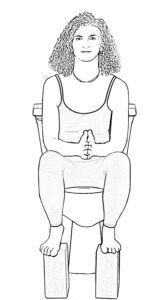
by Leslie Howard
Among all the emails I get from folks who have attended my workshops, the most effusive ones come from women who thank me for my “poop talk,” which consists of me explaining why it is better to squat when pooping rather than sitting like you are in a chair. Many folks have never heard this and then try it, and then they reported back to me that it helped relieve their constipation issues.
For both women and men, sitting improperly in a chair is not conducive to pelvic health because most folks sit without moving for way too long, round their lower backs, and sit on their tailbones, which is a recipe for back pain. The same holds true for how we sit on the toilet. One of the problems with a standard toilet is that it encourages us to tuck our butt under, especially the oval-shaped toilet ring. This position forces the anal canal into a forward-facing position rather than a downward position, which makes it a lot more difficult for waste to get through and out of the intestinal tract and bowels.
If you have spent time around small children, you know that squatting to defecate comes naturally to them. It is the better way to “go” and, in fact, many people around the world relieve themselves in this position using squatting toilets. But somehow we Westerners got it into our heads that the “squatting to poop” method could be improved upon, and we engineered the Western toilet. We should have kept our heads out of our butts. Squatting to poop naturally opens up the butt cheeks, puts the anal canal into the optimal position for release, and creates a natural downward pressure in the pelvis. If you suffer from a rectocele, hemorrhoids, or constipation, squatting to poop could change your life. But please check with your healthcare practitioner about squatting if you have a prolapsed organ. Generally, squatting is not recommended with prolapse.
What exactly do I mean by squatting to poop? Bearing in mind that the ring-shaped toilet seat is not built for folks to squat upon, I am not necessarily advocating that you climb up onto it (although I do). Instead, you can assume a modified squatting position simply by using a footstool or setting up two yoga blocks for your feet at the base of the toilet. Raising your feet off the floor in this way approximates squatting pretty well. For you yoga practitioners out there, this is basically a supported version of squatting known by the Sanskrit name Malasana, but because you have your feet up it is much easier on the knees. You get a two for one here: asana credit plus more expedient pooping equals more free time!
If squatting on the toilet, either by using a footstool or blocks or by doing it with feet on the seat, isn’t comfortable for you, you can practice squatting in your yoga practice with different forms of Malasana, as described next. If you’re a yoga teacher, you can help your students become more comfortable with squatting by including these Malasana variations in your classes.
Getting Comfortable with Squatting
There are three different variations of Malasana that you can practice to become more comfortable with squatting.
To become more adept at moving into, staying in, and moving out of a squat, you can practice an easy form of Malasana where you lie on the floor.
Start on the floor in a supine position (on your back) with your knees bent and feet on the floor, arms at your sides. On an exhalation, draw your abdomen towards the floor to stabilize your lower back and then, while continuing to exhale, bring the knees into the chest and hold the back of the thighs. (If you have lower back pain, you can bring one leg in at a time.). Stay in this position for two or three breaths and then when it’s time to lower the legs back down, begin with an exhalation to stabilize the lower back. When the feet come to the floor, take a deep breath in. Repeat 3-5 times, moving your bent knees in toward your torso with an exhalation and releasing them with an exhalation. This will help your body get used to the shape in a non-weight bearing version.
Once you feel comfortable with knees moving toward and way from the torso, then move on to another version of Malasana that I call “Kitchen Sink Chair Pose.”
Start by facing the kitchen sink about 2-3 feet away from the counter. Take your hands onto the edge of the sink while keeping your hips and legs back about 2- 3 feet away. Then bend and straighten the knees. If this is comfortable, you can begin to walk your feet closer to the sink and each time you bend your knees take the weight of the pelvis back. This is a safe way to meet your body with where you are. And don’t we all stand at the kitchen sink a few times a day.
Now you’re ready to practice Malasana with an upright position on the floor.
Practicing Upright Malasana (Squat Pose)
 This pose increases the sensation in and awareness of your pelvic floor muscles, which can only be a good thing. More awareness of your pelvic floor muscles gives you the advantage of being able to address your challenges more succinctly. For example, maybe your pelvic floor physical therapist told you that you are tighter on the right side but you cannot feel that. A regular practice of Malasana can help stretch that tighter side as well as give you better awareness so that you can use directing your breath into that area
This pose increases the sensation in and awareness of your pelvic floor muscles, which can only be a good thing. More awareness of your pelvic floor muscles gives you the advantage of being able to address your challenges more succinctly. For example, maybe your pelvic floor physical therapist told you that you are tighter on the right side but you cannot feel that. A regular practice of Malasana can help stretch that tighter side as well as give you better awareness so that you can use directing your breath into that area
The pose is performed squatting on the floor with support under the heels. If the knees or back are problematic, practice with a blanket or mat behind the knees. If the upright position is not possible, the pose can be done on the floor on your back by drawing the knees in toward the chest.
CAUTION: Do not do this pose if you have any knowledge or suspicion of a prolapse. Squatting puts pressure into the pelvis, and if not done carefully and with correct alignment, your condition could worsen. If you know of or suspect a prolapse, do the supine version.
How to Practice
- Stand in Mountain pose with a rolled-up blanket or yoga mat under the heels, feet about hip distance apart. Even if you can keep the heels fully on the floor in this pose, use the support under them so that the pelvis can be neutral.
- Slowly bend your knees, dropping the weight into the heels, as though you were going to sit down in a chair.
- Come into a squat; maintain equal weight in the inner and outer heels. Allow the knees to be a bit wider than the torso.
- Bring the palms together and press the elbows out against the inner thighs. At the same time, resist the elbows with the knees. If you wish, you can alternate hand-to-knee position by putting the hands on the outsides of the knees and pressing out with the knees to encourage a subtle action of contrast.
- To come out of the pose, put the hands on the floor and slowly lift the pelvis up toward the ceiling, coming into a standing forward bend. Take a few breaths before standing fully upright. Hinge from the hips to come up.
Modifications
- If your knees bother you while squatting, put a thinly folded blanket or towel behind them as you go down.
- If you feel dizzy coming out of this pose, rise very slowly on an inhalation. Alternatively, come onto the hands and knees before coming up and out of the pose.
- If you feel unsteady in this pose, you can do it with a chair in front of you
to help with balance. To come out of the pose, push your hands on the chair seat. - If you have a rounder belly so that it’s uncomfortable to have the hands folded together in front of the chest, let the hands lightly hold the front of the knees.
Building Pelvic Floor Strength or Releasing Tightness
If you know you need to build pelvic floor strength, as you press the elbows out into the legs and legs into the elbows, lift the perineum toward the crown of the head. You may work on quick flicks or sustained holds of the pelvic floor muscles.
For folks that are dealing with too much tone, you may just want to do a few Malasanas each day for 3-6 breaths and let the shape of the pose and the pressure that it creates in the pelvic floor stretch you out.
For more information on the pelvic floor and yoga poses that can help, see my book Pelvic Liberation at www.lesliehowardyoga.com or Amazon.com.

Leslie Howard is an Oakland-based yoga teacher, specializing in all things pelvic. She leads workshops and trainings nationally and has written a book about caring for the female pelvis, Pelvic Liberation. She is a regular presenter for the Yoga Journal conferences and a regular contributor to Yoga Journal magazine. Her own struggles with healing her hips and pelvis led her to intense study of the anatomy, physiology, cultural messaging, history, and energetics of this rich area of the body. Her teaching is informed by over 3500 hours of yoga study with senior Iyengar yoga teachers. She considers Ramanand Patel her most important influence and mentor. She has designed two very successful studies for UCSF on how to use yoga to alleviate incontinence and pelvic pain.
• Follow Yoga for Healthy Aging on Facebook and follow Nina on Instagram • Pre-order Yoga for Times of Change: Practices and Meditations for Moving Through Stress, Anxiety, Grief & Life’s Transitions here • Order Yoga for Healthy Aging: A Guide to Lifelong Well-Being here


Leave A Comment